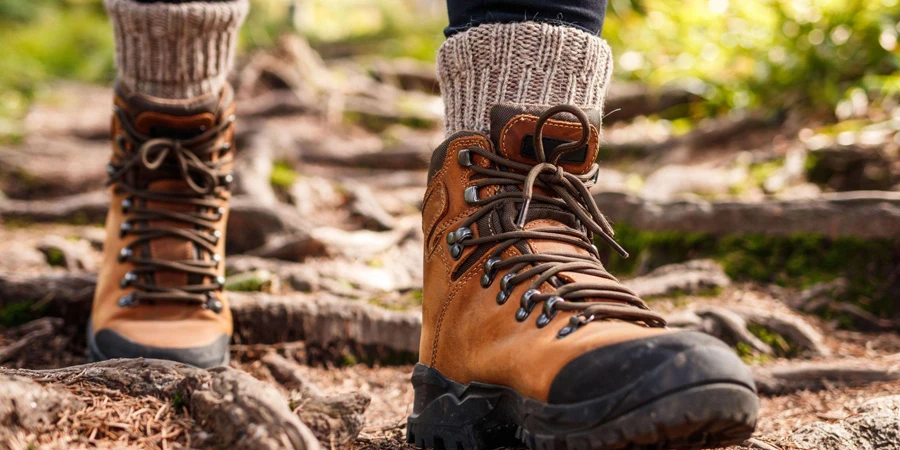Table of Contents
Introduction
Hiking Footwear(Shoes & Boots) Market Dynamics
Considerations of Selection
Top Picks in 2024
Conclusion
Introduction
In the quest for outdoor adventure, selecting the right hiking shoes(boots) is paramount, not just for navigating the trail but also for ensuring safety and comfort. The year 2024 marks a significant leap in hiking footwear, with technological advancements finely tuned to hiker preferences. This evolution reflects a deeper understanding of diverse terrains and personal needs, leading to innovative designs that meld durability with comfort. As we traverse into this new era, the latest hiking shoes(boots) offer a harmonious blend of materials and features, from enhanced waterproofing and breathability to optimized weight and flexibility.
Hiking Footwear(Shoes & Boots) Market Dynamics
The global hiking footwear market, which includes hiking shoes and boots, was valued at approximately USD 19.70 billion in 2023. The market is projected to grow at a compound annual growth rate (CAGR) of 3.1% from 2023 to 2033, reaching an estimated value of USD 26.73 billion by 2033. In the United States, hiking footwear sales are expected to increase at a CAGR of 3.9% and reach USD 8.63 billion by 2033. The hiking shoes segment is estimated to reach a market valuation of USD 9.92 billion by 2033.
Key players in the hiking footwear market include New Balance, Adidas AG, VF Corporation, Mizuno Corporation, NIKE, Sketchers USA, Deckers Outdoor Corporation, Amer Sports Corporation, Wolverine World Wide, PUMA SE, and Under Armour.
Considerations of Selection
Hiking Shoes vs. Hiking Boots
Hiking Shoes are lightweight and flexible, featuring a low-cut design for less ankle support but greater agility. They’re ideal for day hikes on maintained trails and suit fast-paced hiking or trail running, especially in warm, dry conditions. Their main advantage is comfort and the ability to maintain a quick pace. However, they offer less protection on rough terrain and are not ideal for carrying heavy backpack loads due to reduced foot and ankle support.
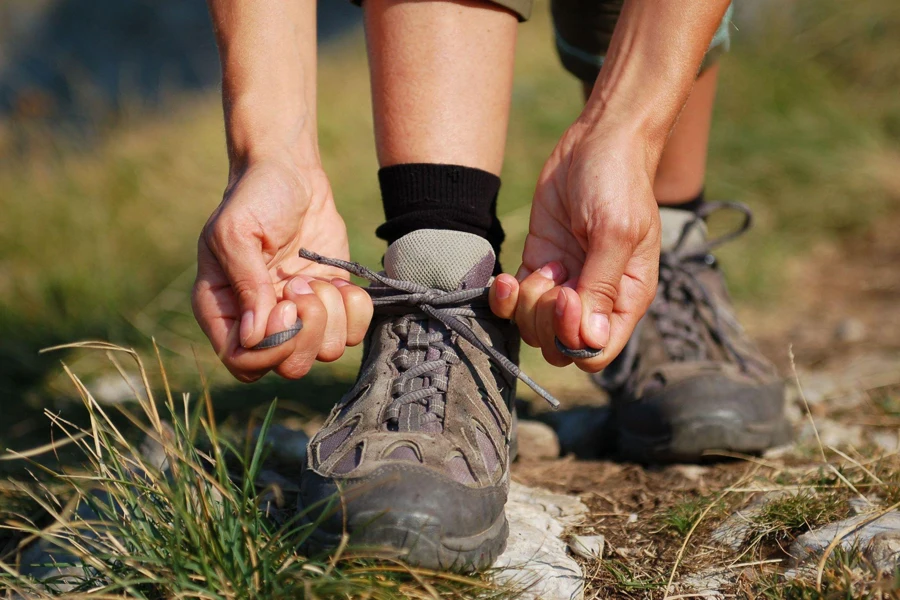
Hiking Boots, in contrast, are heavier and provide robust foot and ankle support with a high-cut design. Made with durable materials, they’re well-suited for multi-day trips, rugged terrains, and varying weather, including wet conditions. They excel in protecting feet and ankles during challenging hikes and are great for carrying heavier loads. The downside is they can lead to quicker fatigue due to their weight and may be less comfortable in hot conditions due to reduced breathability.
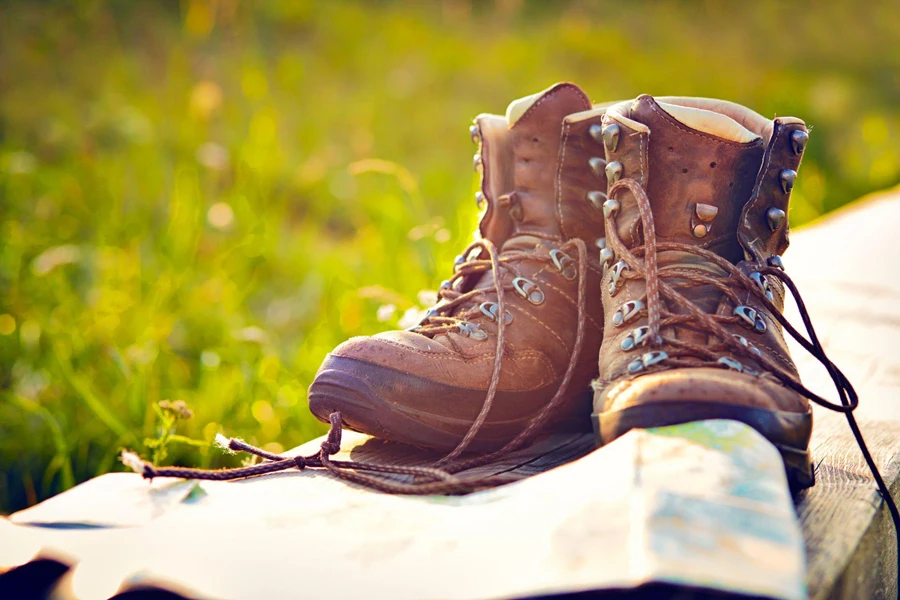
Terrain Types
1. Flat and Well-Maintained Trails
- Shoe Characteristics: These shoes are generally designed with comfort in mind for easy trails. They feature moderate cushioning, breathable materials, and soles with sufficient grip for standard trails.
- Ideal For: Perfect for leisurely hikes, walking on groomed park paths, and anyone who enjoys outdoor activities without the technical challenges of more demanding terrains.
2. Rugged and Rocky Terrain
- Shoe Characteristics: Built for durability and stability, these shoes often have reinforced toe protection, enhanced arch support, and aggressive tread patterns to handle uneven and sharp rocks.
- Ideal For: Suited for experienced hikers who frequently explore off-beaten paths, engage in hill walking, and navigate terrain with loose stones and steep inclines.
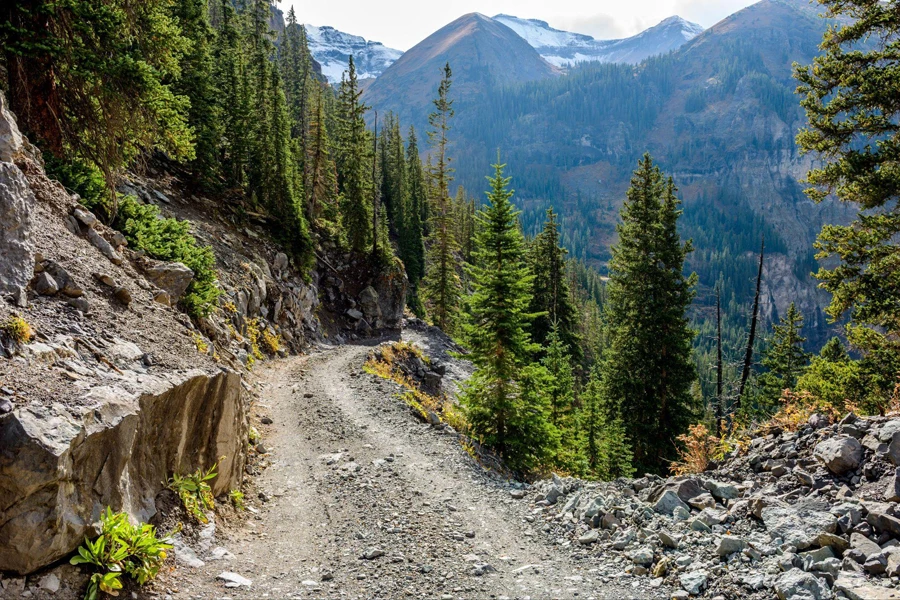
3. Mountainous and Alpine Conditions
- Shoe Characteristics: These boots offer robust ankle support, stiff soles for better grip on steep slopes, and often include features for additional safety like crampon compatibility.
- Ideal For: Aimed at mountaineers and serious hikers tackling high-altitude treks, steep ascents, and potentially snowy or icy conditions.
4. Wet and Muddy Conditions
- Shoe Characteristics: Prioritizing waterproof materials like GORE-TEX, these shoes also offer aggressive soles for mud traction and quick-drying uppers to reduce discomfort.
- Ideal For: Best for trails prone to rain, streams, or marshy areas, and for hikers who don’t let wet weather deter their hiking plans.
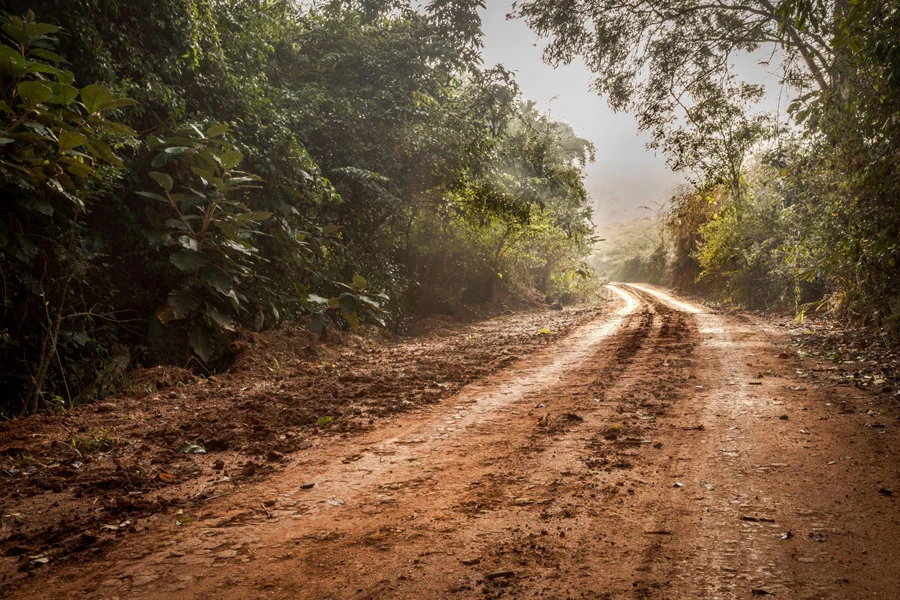
5. Mixed Terrain (Varied Landscapes)
- Shoe Characteristics: A blend of durability, flexibility, and comfort, these shoes adapt to various conditions, offering a good balance between protection and ease of movement.
- Ideal For: Designed for hikers who enjoy diverse hiking experiences, from forest floor trails to rocky, undulating terrains.
6. Desert and Hot Climates
- Shoe Characteristics: Emphasizing breathability, these shoes often feature light materials, ventilated design, and soles equipped to handle sand and slick rock surfaces.
- Ideal For: Optimal for hiking in arid, hot environments where heat management and preventing foot overheating are critical.

7. Winter and Snowy Conditions
- Shoe Characteristics: Insulated for warmth, these boots typically include waterproofing and are designed to provide stability and grip in snowy, icy conditions.
- Ideal For: Essential for winter hikes, snowshoeing, and navigating trails in cold weather, where keeping feet warm and dry is a priority.

Materials:
In hiking shoes, materials like nylon, mesh, and leather are commonly used, each offering distinct benefits. Nylon is chosen for its balance of lightness and breathability, ideal for maintaining comfort on the trail. Mesh, often incorporated with nylon, enhances air circulation, reducing sweat and keeping feet cooler. Leather, used in more rugged hiking shoes, stands out for its exceptional durability and ability to withstand tough terrains, though it sacrifices some breathability compared to nylon and mesh. The choice of material significantly impacts the shoe’s performance, especially in terms of breathability and protection against the elements.
Durability:
The longevity of hiking shoes largely depends on their material composition and the intensity of their use. Lightweight materials like nylon and mesh, while comfortable and breathable, may not endure harsh terrains as effectively as leather. The outsole’s material also plays a crucial role, with softer rubber wearing out faster than firmer alternatives. Regarding lifespan, lighter shoes designed for trail running or less demanding hikes might need replacement after 300-500 miles. In contrast, more robust hiking shoes, designed for heavier loads and more challenging trails, can last between 500 and 800 miles. This durability makes them suitable for serious hikers who spend extended periods on diverse and demanding trails.
Foot Shapes:
Wide Feet: For those with wide feet, it’s essential to choose hiking shoes with a wider toe box to ensure comfort and prevent cramping. Brands like Altra, known for their Lone Peak series, often design shoes that provide extra space, catering to wider foot dimensions. This roomy design allows for natural toe spread, enhancing stability and comfort on the trail.
Narrow Feet: Hikers with narrow feet should look for shoes that offer a tighter fit to secure the foot and minimize internal movement, which can lead to blisters. Some brands are recognized for their narrower fit, ensuring a snug, supportive embrace of the foot, particularly beneficial for slender feet, enhancing stability and reducing slippage.
High Arches: If you have high arches, selecting hiking shoes with ample arch support is crucial. These shoes should accommodate custom orthotics if needed. Models with enhanced cushioning provide additional comfort, helping to distribute pressure evenly and reduce strain on the arches during long hikes.
Flat Arches (Low Arches): For flat arches, it’s important to choose shoes with a structured midsole offering support where natural arch curvature is lacking. Stability features in the shoe can help counteract overpronation, a common issue for flat-footed hikers, ensuring a more balanced and comfortable stride.
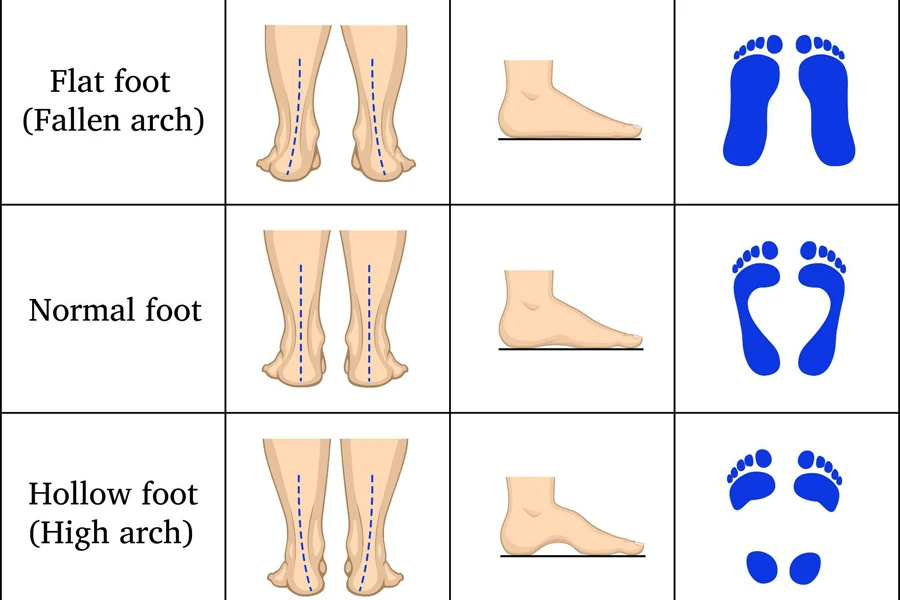
Waterproofing vs. Breathability
When it comes to hiking boots, striking the right balance between keeping water out and letting your feet breathe is crucial. Modern boots often incorporate materials like full-grain leather for excellent water resistance and durability, ideal for extended backpacking trips. However, they’re not as breathable as boots made with split-grain leather or synthetics, which are lighter and more breathable due to their nylon composition. For those hiking in wet conditions, boots with waterproof membranes like Gore-Tex are a game-changer. They effectively block external moisture while allowing internal moisture to escape, keeping your feet dry. But in warmer, drier climates, opting for boots that prioritize breathability over waterproofing can lead to greater comfort, as they prevent feet from overheating.
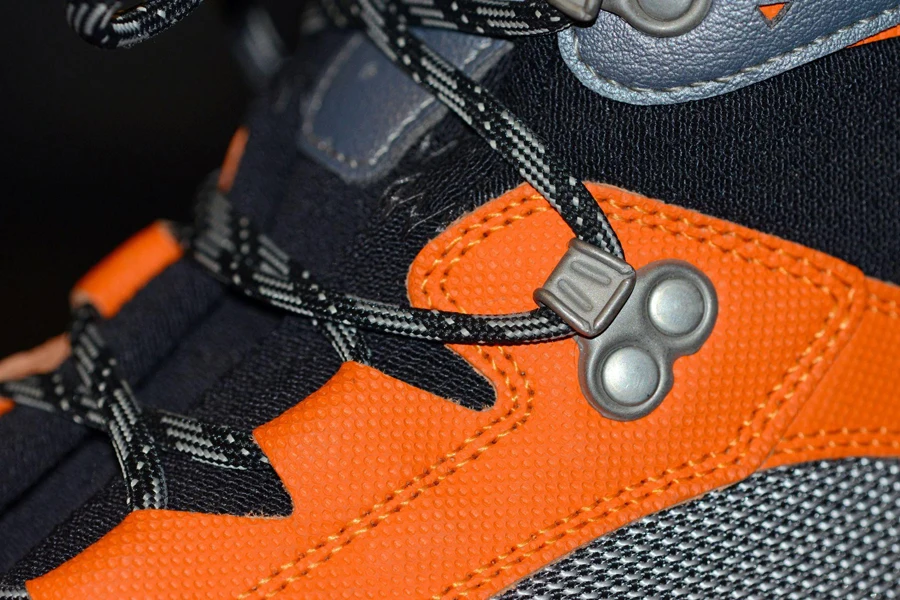
Weight vs. Flexibility
The weight and flexibility of your hiking boots can significantly impact your hiking experience. Lightweight boots, often made with cushier EVA midsoles, are a favorite for day hikers and those who prefer agility and speed on the trails. These boots offer the flexibility needed for comfortable movement but might lack the support required for rough terrains. On the other hand, heavier boots, typically featuring more durable polyurethane midsoles, are designed for challenging terrains and carrying heavier loads. They provide excellent support and stability, essential for long, strenuous hikes. While they might be less flexible and require a break-in period, their robust construction ensures your feet are well-protected and supported, no matter the terrain.
Top Picks in 2024
In 2024, the hiking footwear market has seen remarkable innovations and designs, catering to a diverse range of hikers’ needs. Here’s an overview of some of the best hiking shoes and boots of the year.
Salomon X Ultra 4 Mid GTX
The Salomon X Ultra 4 Mid GTX continues to be a top choice for hikers seeking a lightweight yet supportive boot. It’s built like a trail running shoe, offering added ankle support and protection. The boot’s updated design features a sleeker upper and revised chassis, enhancing both comfort and low weight. It retains solid toe protection, stability, and well-rounded traction. Despite its lightweight construction, it may lack underfoot protection compared to heavier boots. However, its durability, protection, and support make it a favorite among fast-moving day hikers and lightweight backpackers. The X Ultra 4 Mid GTX is also available in wide sizes, catering to a broader range of foot shapes.
Merrell Moab 3 Mid WP
The Merrell Moab 3 Mid WP stands out for its exceptional comfort and value. Ideal for day hikers and lightweight backpackers, this boot offers a foot-friendly design with great cushioning and reliable Vibram outsoles. The Moab 3 features Merrell’s in-house waterproof membrane, ensuring dry feet in wet conditions. The recent update includes more recycled materials and slightly more aggressive traction. While it may not be as nimble as some modern alternatives, its comfort and performance at an affordable price make it a popular choice.
La Sportiva Ultra Raptor II
La Sportiva’s Ultra Raptor II is praised for its performance in fast-and-light mountain adventures. This boot strikes a balance between a mid-height trail runner and a hiking boot, offering both protection and agility. It’s known for its excellent stability and durability in a lightweight design. The Ultra Raptor II Mid GTX is particularly effective in technical terrain, thanks to its rigid shank and FriXion XF 2.0 sole that provides excellent grip on rock. However, its traction may fall short in muddy conditions. The boot’s design is ideal for hikers who prefer a lightweight option but require more technical features.
Hoka Anacapa Mid GTX
The Hoka Anacapa Mid GTX is recognized for its maximum cushioning and comfort. It features Hoka’s signature springy midsole and a rockered shape for a smooth ride on trails. The boot combines a trail runner-like feel with the structure of a hiker, making it suitable for backpacking trips. The Anacapa Mid GTX includes durable nubuck leather and a Gore-Tex waterproof liner. However, there are concerns about the durability of its outsole, particularly in rocky conditions. The Anacapa 2, with sustainability-minded upgrades, is currently being tested for further improvements.

Conclusion
This evolving landscape of hiking footwear, driven by consumer demand for versatile, high-performance gear, offers potential for product diversification and market expansion. Retailers can capitalize on this by curating products that cater to varying hiker needs, from lightweight designs for casual treks to durable models for challenging terrains. Understanding and responding to these specific consumer preferences is key to securing a strong position in this dynamic and competitive industry.
